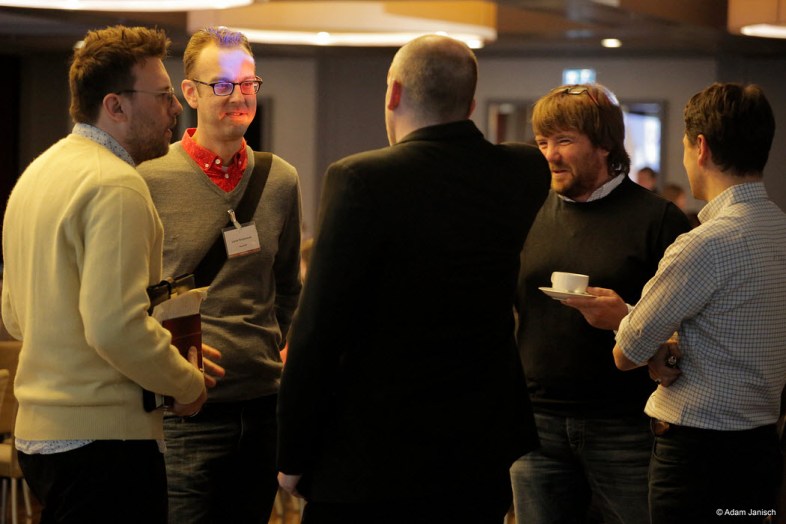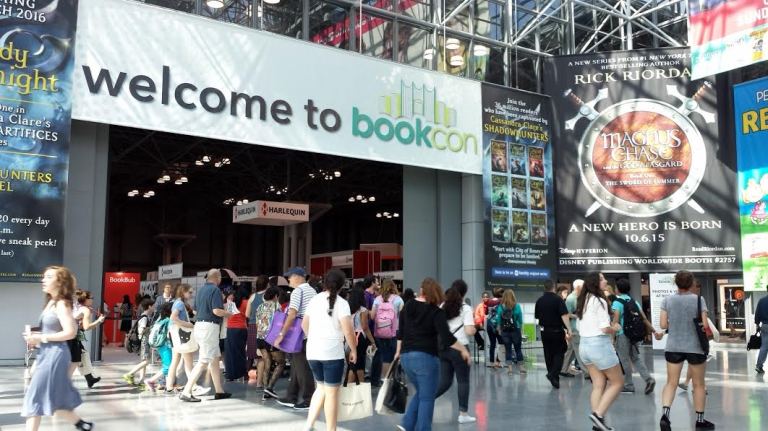‘Publishing Goes Pop,’ Part 1: Can Reading Find True Fandom At BookCon?
20,000 BookCon fans are expected to cap this year's BookExpo America trade show (BEA) in New York. How do books unleash such passion? BookCon creator Lance Fensterman of ReedPOP at Berlin's Publisher's Forum tells his audience that when "Publishing Goes Pop," creators and consumers come together.


‘There Was No Interest At BEA In…Readers’
BookExpo America (BEA) makes its annual appearance next week (27-29 May). It’s one of the world’s big-three publishing trade shows of the year, preceded in April by London Book Fair and followed in October by the largest of all, Frankfurt Book Fair.
And while the show officially ends on Friday the 29th, it doesn’t actually stop. On Saturday and Sunday, 30 and 31 May, it morphs, in a way. The carpeted aisles and book-shelved booths and pavilions at New York City’s Jacob Javits Center are to be all but overrun by thousands of that most-hankered-for demographic: 18- to 35-year-olds.
Last year, this occurred only on the Saturday of BEA. This year, both the Saturday and Sunday will host BookCon — “where storytelling and pop culture collide.”
Having drawn 10,000 visitors on Saturday in 2014, there’s a pre-event sellout anticipated of 20,000 total tickets for the two-day BookCon this year.
And the fact that something called “BookCon” might be that popular to so many people is part of what prompted publishing analyst Rüdiger Wischenbart to create a key session at Klopotek AG’s Publishers’ Forum in Berlin in late April called “Publishing Goes Pop.”
Lance Fensterman, ReedPOP
I was glad to be asked to moderate the “pop” panel in Berlin because Wischenbart handed me four well-chosen speakers to explore the question of that “collision” that the BookCon blurbs refer to. I was joined by:
- Lance Fensterman of ReedPOP, the creator and producer of BookCon;
- Andreas Gall, technology chief with Red Bull Media House;
- Publisher Michael Bhaskar of London’s Canelo; and
- Nathan Hull, the former Penguin Random House executive now leading business development for Copenhagen-based Mofibo, an ebook subscription service — and in an earlier career, the European manager for INXS.
I’m breaking my writings on this panel into two parts so that we can take advantage of the “second coming” next week of BookCon, and of the affable Fensterman’s first-hand insights into its development and context. In the second part of this coverage, we’ll hear from our other panelists and widen the issue of the books world, “pop,” and fandom. If we’re talking about a collision, what can we in the books world learn from what the “pop” people know about the loyalty and energy of fans?

As I said in my opening remarks in Germany, the world of book publishing easily can be forgiven for coveting the massive crowds that pop-culture fancom commands. Note that in the graphic from BookCon here, you’re seeing a 74-percent cut of that “con” audience reading three to six books per month. This is huge.
And before you say we’ve never seen anything like this in books before, think again.
I reminded our audience in Berlin of the siege of Piccadilly in London last September when YouTube star and author Alfie Deyes arrived at the Waterstones bookstore for a signing — to find almost 8,000 admirers waiting for him. That event had to be curtailed. Unlike BookCon, which is designed to handle such traffic, Waterstones Piccadilly was overwhelmed. Here is my colleague at The Bookseller in London, Sarah Shaffi, on the incident in Huge crowds force Deyes book tour postponement:
A spokesperson for Waterstones said: “The interest in Saturday’s Alfie Deyes event was unprecedented. Alfie did manage to meet over 800 fans on the day which made it our biggest signing of the year so far.”
In short, there are times when we’re seeing something that looks like a populist-big response to what has been considered the niche-ier, specialized entertainment attractions of books and reading. What do we know about these instances? What do they tell us?
BookCon: Big, Yes, But What Is It?

BookCon’s advent last year, left a lasting impression on the US publishing industry, but it’s hard for some in the business to understand what to make of this type of win, another good reason for Wischenbart’s programming.
BookCon is a kind of success unexpected in many old-industry quarters. “They’ll never show up” was wrong. “They’re not interested in book culture” was wrong. “They’ll never give up a Saturday to troop through the Javits Center for a good time” — that was wrong, too.
The large pavilions installed at the Javits Center by major publishers — let alone the makeshift events stages and small stands or booths bought by service companies — had never witnessed the wall of bodies that moved into the space as the doors opened on a Saturday morning last May.
The Alliance of Independent Authors‘ Orna Ross was one of the writers who had taken a table at BEA’s Author Hub last year. She told me that having spent most of BEA week without shifting many copies of her books, she was able — suddenly — to give away 500 copies within hours when BookCon opened. She had felt silly for bringing that many copies from London, she said. She ended up very glad to have had them when the BookCon army came marching in.
And that’s an author’s eye view of what was underway — and underfoot, decidedly Nike-d — in this unprecedented shift of a trade show’s dynamic.
- On Friday, BEA 2014 was still “B2B,” business-to-business, a trade show.
- On Saturday it flipped into something “B2C,” business-to-consumer.
- And those consumers arrived in droves.
Our first speaker on the panel in Berlin was Fensterman, on the birth of BookCon and on how he sees its imposing arrival on the scene.

The wry, likable Fensterman — Global Senior Vice-President of ReedPOP USA — is, in fact, the former director of BookExpo America, itself, a post now held by the very able Steven Rosato. Just to be clear on the connections here:
- BookExpo America (BEA), the trade show, is produced by Reed Exhibitions.
- BookCon, the fan event at BEA’s Javits Center site, is produced by ReedPOP.
- ReedPOP bills itself as “a quirky offshoot of Reed Exhibitions,” still less than a decade old, a new sister company created to do “con”-style production: fan events.
In Berlin, Fensterman gave us the perfect opener to the panel’s discussion by explaining why the huge books trade show in New York had even considered looking for an audience in non-bookish places. Cons, after all, tend to attract lots of young people wearing bathrobes and carrying plastic light sabers.
Fensterman started with that B2B basis for the typical trade show, and looked back at the last decade at BEA:
We felt encumbered by the traditional business models [of trade shows]. When you think about a more traditional model, it’s all about brands. We had a belief that the traditional model of B2B — of brands influencing intermediaries who then would influence consumers — was going away. We thought we needed to create a divergent business model and a divergent culture to facilitate that more freely.
Fensterman got a healthy laugh from the Berlin audience when, to explain why the traditional Reed corporate identities weren’t ready to accommodate a new effort in outreach to “early adopters 18 to 35.” As you can see in these two slides from his presentation, Reed Exhibitions and Reed Elsevier have a certain look and feel, on the left below. ReedPOP has a very different personality, captured in the shot on the right.

Fensterman:
I ran BookExpo America. BEA, like a lot of trade book shows, was just kind of bumping along. Its relevancy had changed, its buying patterns had dramatically changed, its value to…publishers had changed. And by “changed” I mean had got worse. I’m just trying to put it nicely.
This was 10 years ago. So we looked at BEA and said, “Well, what’s growing? What’s happening in publishing that’s exciting? Graphic novels, manga, anime were still growing. They were still finding a passionate audience. So we took a rib out of BEA and launched New York ComicCon for consumers.
Fensterman and Reed expected that 8,000 to 9.000 people might attend the first New York ComicCon.
About 18,000 people showed up. The police shut us down. People who bought tickets couldn’t get in. People who didn’t buy tickets did get in. But it did show us that we were on to something, we had unlocked something about this passionate fan base.
Freely admitting that “we didn’t know what we were doing” in that first instance, Fensterman and his associates — ReedPOP in the making — quickly put together what they needed to know to present the roughly 25 massive “con” events they now stage in various parts of the world each year.
Lance Fensterman, ReedPOP
In those 25 events, they cater to more than 1 million fans, 70 percent of whom are 18 to 35 years old.
As many as 5,000 brands exhibit at these events, in total, in order to reach that prime audience.
Using what Fensterman describes as “zero marketing dollars,” ReedPOP today sells 90,000 tickets annually at an average $40 each.
And what they’re selling to the fans, he says, is access: fans want to get close to the creators of the content they love.
‘Over My Dead Body Will Consumers…Set Foot In BEA’
In Berlin, Fensterman laid out the challenge that Reed responded to in the middle of the last decade:
The reason that New York ComicCon was a separate event, taken out of BEA, is that at that point in time, in 2006, there was no interest from our customers at BEA in having anything to do with readers. Consumers. None. The publishing community did not want to interact with them, to the point that the head of one of the major houses said, ‘Over my dead body will consumers ever set foot in BEA.’
So we said, “OK.” And we went and did it on our own.
What’s come out of that is the fastest-growing business that Reed has globally, and that’s ReedPOP, which is catering to fans. But what’s rewarding is coming full circle. As BEA continued to bump along, as a lot of trade book shows did, we took ReedPOP and introduced BookCon at BEA. Our goal, frankly was to shake things up, to bring those passionate fans, those passionate consumers, into BEA.
Here’s an irony for you.
BEA this year will be opened by the International Digital Publishing Forum’s (IDPF) Digital Book Conference. I’m program director of #DigiBook15, as we’re hashtagging it, and including its Book Industry Study Group “Making It Pay” sequence, the show features some 90 speakers in 35 sessions across two days.
Our theme this year: “Putting Readers First.”

Menswear Dog and Geek Girl Brunch
BookCon is made up of many, many events, and in that regard doesn’t look on paper all that different from BEA. Just as at the trade show, many things occur at the same time. Depending on who you’re talking to, that’s either good or bad. If you’re having to miss two things you’re dying to see in order to see a third, you’re not happy, but this seems to be a Reed-wide hallmark: give them competing events. An events tab directs you to myriad panel discussions, autograph sessions, YouTube photo ops, screenings, and a “Special Events Hall Panel Process,” which turns out not to be an event but pure crowd control:
As you enter the Queue Hall, you will see three whiteboards. These whiteboards will tell you which Special Events Hall Panels have space available and which are at capacity. We anticipate that some Panel lines will fill up quickly so please plan accordingly. Walk straight past the Special Events Hall Panel whiteboards to the back of the Queue Hall. At the back of the Hall, you will turn left to get into the line for the Special Events Hall Panel you want to see.

What’s different — beyond wristbands placed on you by security for each panel you want to see — is the content, its populist consumer appeal, how things are positioned — and how they’re described, too. There’s a frankness to the lingo used in these pitches. “Swag” is on offer. For example, the Geek Girl YA Brunch is a co-production of Random House, BookCon, Books of Wonder and Geek Girl Brunch. One irony any literature person will note here is that BookCon copywriters have a great fondness for exclamation points. But that, of course, is just the thing. BookCon is doing something else:
Come make a new friend, meet your favorite author and win some swag all while feasting on cookie dough pancakes! This is a brunch fit for our favorite YA heroines and you don’t want to miss it!
Who’s on tap? Pack a lunch if you plant to scroll to the bottom of the list. Here are author John Green, 20-year-old actor Nat Wolff, screenwriter Michael H. Weber, and composer Ryan Lott talking up Green’s Paper Towns — the film is due out in July. More of the weekend’s 200+ “guests” are The Office’s BJ Novak, 21 Jump Street’s and Room’s Brie Larson, Room’s Emma Donoghue, author and YouTuber Joey Graceffa, author Judy Blume, a couple of Davids you know — Baldacci and Duchovny. And my pal, author and television personality Brad Meltzer, is going to have to look pretty sharp to outdress Menswear Dog.
One way to think of this is along the lines of that great digital era mantra: disrupt yourself before someone else does it to you.
ReedPOP’s BookCon is a decided disruption of Reed Exhibitions’ decades-old BEA trade-show model and when Fensterman talks about it, you get the feeling that there were some intense moments of corporate discussion about just what was going on. “We wanted to take that hybrid model of B2B/C and create a model of “E2E” — end to end — where authors, creators were interacting directly with their passionate fan bases.”
This is the key concept in Fensterman’s construct for the “con” effectiveness, something beyond even B2C in which makers and users come together. “We did [last year’s BookCon] in about 45 days, from concept to execution. A one day event. We sold out.”
This year’s sellout will have been created with more lead time and some lessons learned from the 2014 debut of BookCon:
We learned that we had to guide publishers about content. They tended to want to bring a type of author who was not interesting to us. But…we actually were quite firm about declining on a number of marquee authors they wanted to bring. They simply did not fit that model of a passionate fan base. It was great for them, their marquee author but I had no interest in them because they didn’t fill that niche passion that we wanted.
And this is where Fensterman in Berlin slowed down and interrupted his own presentation’s delivery to issue a warning to publishers trying to make the leap in their thinking from the stereotypical readership base in literature to something with the energy and scale of fandom:
I want to be careful when I say “niche” and “passion.” Don’t excuse this as genre, okay? Don’t excuse this as zombies or aliens. It’s not true and it’s not fair. It’s over-simplifying and it’s undervaluing this fan base. These are rabid consumers of content. You’ve got to find the right kind of content…there’s a much broader play to be made here.
We had to say to publishers, “No offense, but we don’t want your traditional marquee authors at this show. We’re not looking to engage the 45- to 55-year-old reader. You already have that reader. That’s not the problem.
We’re saying, “How do you get those passionate, passionate fan bases 18 to 35? How do you engage the YouTube generation?
Looking back at last year’s Bookcon, Fensterman says, “It was a wild success. it scared the crap out of a lot of people at BEA. That was wonderful. That’s what we wanted to do, jar things a bit.”
If trade shows are a reflection of an industry, with all pertinent players present, Fensterman says, the E2E — end to end, creator to consumer — “is a lot simpler” than the standard B2B/B2C model with corporate elements between the creator and consumer in one way or another.
E2E, Fensterman says, “is going to put a crate” in the traditional ecosystem of companies arrayed in proximity to each other. In connecting a passionate fan base with who they want to see (a creator) means that those who can enable such connections will profit; those who are in middleman roles will not.
The question in publishing is how do we go from reaching our traditional audience, which we’re already talking to, to reaching passionate fans in all the different genres and ways we need to? How do we do this? How do publishers take your creators, the content you have that’s so valuable, and connect it with a passionate fan base? How do you connect and foster passionate fan communities?
Next week, the search for answers to that question arrives on the 40,000 feet of 20,000 “passionate fans” at the two-day BookCon at BEA.
Fensterman:
Ten years ago, publishers were still saying “over my dead body.” Ten years later, they’re thrilled and frightened that we’ve introduced 10,000 passionate consumers [per day] into a traditional business to business model. How do we do that across the board?
More on what it means when “Publishing Goes Pop” in Part 2. ![]()




